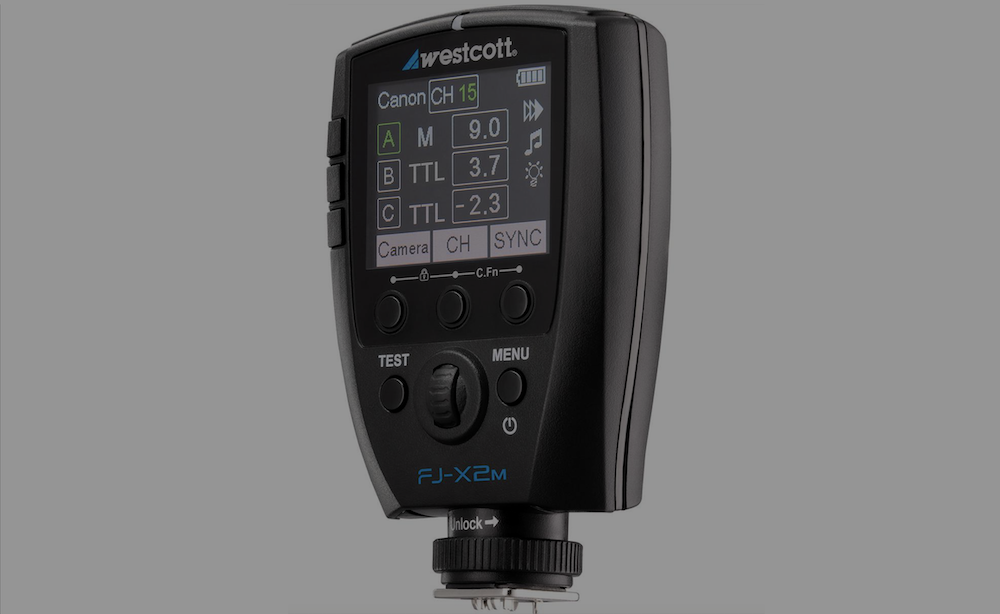I previously shared articles testing the Westcott FJ80, FJ200, and FJ400 to see how they compared to my R2 series flashes. The results were mixed with the lights going back and forth on key specs like power, color, speed, and portability.
One massive benefit to the FJ and R2 series of flashes is that all of their features can be controlled remotely. Gone are the days of running over and pulling down your light stand just to change the output of the flash by a third stop. From the transmitter, photographers can control the flash output, change the mode between manual and TTL, activate HSS, and control additional settings of the flash.
On the Westcott FJ series, this is handled through the FJX2M Universal Wireless Flash Trigger. I’m not going to compare the FJX2M directly to anything in the R2 series because there are five different transmitters available to trigger R2 lights. However, I will share the pros and cons I found using the Westcott FJX2M.
Universal

The first unique feature of the Westcott FJX2M is that the shoe is “Universal.” The FJX2M is fully compatible with Canon, Nikon, Fuji, Olympus, Lumix, and Sony. Sony requires the use of an adapter.
The universal aspect has two key benefits. If you use multiple camera brands, you don’t need multiple triggers just to have full compatibility. If you switch camera brands, you don’t have to buy new lighting equipment. This also makes sharing triggers way easier. In my studio, we have five R2-T transmitters to satisfy all camera brands that renters may bring in, but that weight could be pulled by a single FJX2M.
The only downside is Sony requires an adapter. Personally, I like to minimize the amount of pieces necessary to do my job. It simplifies life and decreases the chance of failures. So, while I think this is a great feature for a majority of photographers, other Sony users may also find it negative. I would happily forego the universal aspect for a Sony-only version.
Tilt-Lock

The Westcott FJX2M transmitter can freely tilt, and locks in three positions. It can lock upright, horizontal, and around 30 degrees up from horizontal. It also has the perfect amount of lock such that it stays fixed in the position you set it but easily moves when you want to change positions.
I love this feature, as you can easily see the screen whether your camera is mounted high above you and all the way to waist level if you have your camera mounted on a tripod.
Display and User Interface

The screen is black with white text, with active features displayed in green. This makes it abundantly clear what you are adjusting, and goes a long way in making the UI clear for those new to the system. It’s also highly visible, even in bright conditions. The controls are simple with only three buttons on the left to select groups, five buttons below the display for controls and menu access, and a single dial for adjusting the power of the flash.
I would give the UI a score of 9/10. The only negative I can think of is, as a power-user, I find the dial somewhat slow for making output adjustments. The interface adjusts power in 1/10th stop increments, and the wheel is limited to about six or seven clicks at a time. You do have the option to long press the center button to switch to full stops, but it takes about 1.5 seconds to switch in and out. I prefer a dial that allows for your thumb to rotate in full circles like the R2 Pro II for more rapid adjustments. If Westcott adds 1/3rd stop control as a custom function via a firmware update, I’d give the UI a 10/10.
Internal Battery & Battery Life
The FJX2M battery is contained within the unit which means once it runs out of juice, you have to charge it via a USB type-C cable. At first I thought this was a non-issue, as transmitters tend to last weeks if not months when powered by AA. Unfortunately, that is not the case with the FJX2M. I found the battery would last about one long day of shooting before it hit its final bar and I felt the need to charge.
I’m not sure why it’s battery life is so short, perhaps it communicates the power level with every fire signal. I find this to be a negative because you can’t immediately swap the batteries when you run low. You would need to switch to a backup transmitter, or rig some type of USB charger to your camera. As someone who generally shoots events with two camera bodies — both with transmitters on top — I dislike the idea of needing four transmitters to confidently get through a busy weekend.
Six Groups
The FJX2M transmitter displays three groups at a time. Although, by scrolling down on the screen, you will find access to control up to six groups of off-camera lighting. I appreciate the split screen as I think most strobists and session photographers use less than three groups of off-camera flash. This allows the groups and power levels to be displayed large and bold. But power users who have five or six groups of off-camera flash still have easy access.
Conclusion
The Westcott FJX2M is an extremely well-designed trigger that is simple to operate. The tilt function, six groups, and universal properties make it a great option for all levels of photographer. I can look passed the adapter, even though I would really appreciate a Sony-only version to rid my case of the small adapter. The battery life and internal battery would give me pause as someone who often shoots through long days, but I think most session photographers would find it tolerable. If I bought into the system, I’d be purchasing a USB power bank to live in my camera bag alongside it.
Article and Photos by Robert Hall.

